If your team wants a regular and impactful content output, you’ll need to have a firm idea of what you want to publish and when.
Creating content is a whole lot more than just waiting for inspiration — it takes proper organization, without which your content can all too easily flop.
Explore this guide to building an effective content calendar for your company and download the content calendar template below to apply everything you learn into practice.
What Is a Content Calendar Template?
Simply put, a content calendar — sometimes known as an editorial calendar — is a written schedule used by bloggers, marketers and all kinds of businesses to record when and where they plan to publish upcoming content. These helpful tools are typically put together by individuals or teams looking to focus their editorial output over a given period of time.
Using a content calendar can help you to track your or your team’s content creation workflows and planned publication dates, helping keep your efforts on track. Content calendar templates can make these tools easy to create and replicate.
Types of Content Calendars
In the same way that there can be many types of content, so too can there be many types of calendars.
As demonstrated by this previous article on content calendar examples, it can be helpful to have different calendars for different kinds of output. For example, you might create social media content marketing calendars and content calendars for blogs, emails, lead magnets, landing or product pages, and other regular content you produce. Sometimes you might even want to create a joint calendar for all types of content created in your company.
We will revisit this point later though so, for now, let us look at how to assemble the foundations of a successful content calendar.
Our 8-step Template for Building a Content Calendar
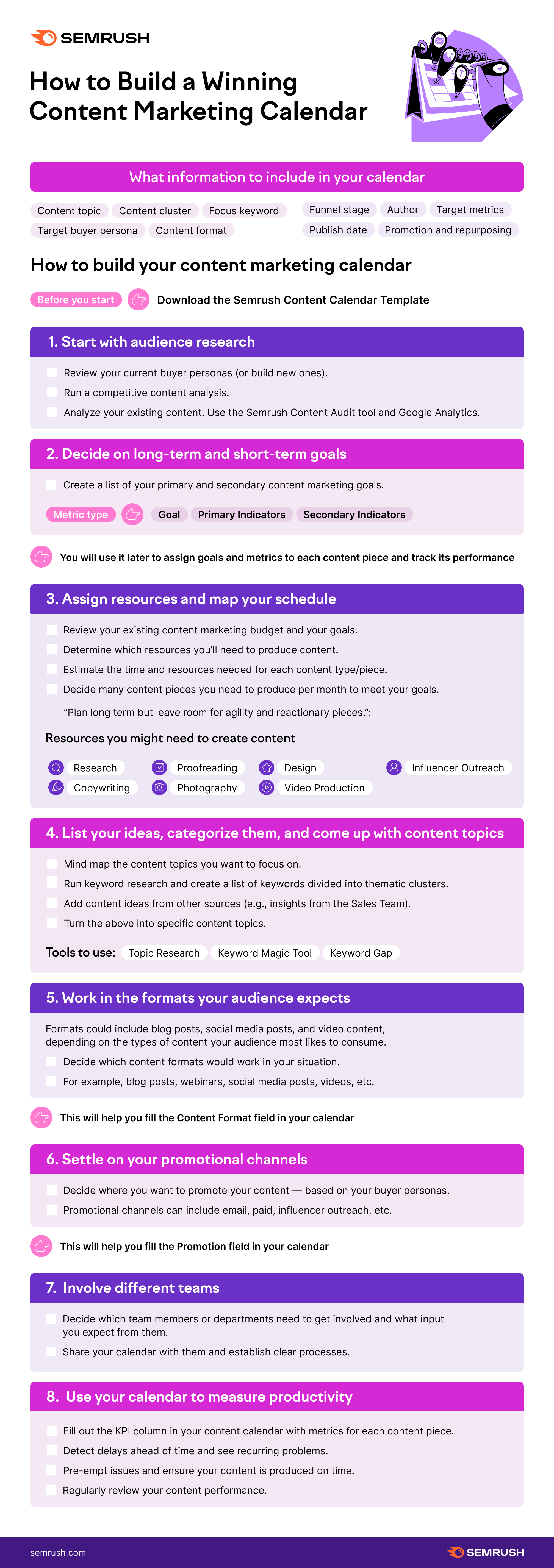
Ready? Good. Coming up are eight key steps to first start building a calendar that will help you plan your content and establish a strong content strategy.
Start by downloading the Semrush free content calendar template, select the calendar type that suits you the most, and then follow the steps in this blog.
The rows of your content calendar will be set aside for each new piece of content and the columns will contain information on what the individual articles contain. These columns can focus on:
Content topic Content format Publish date Content cluster Targeted buyer persona Focus keyword Funnel stage Target KPIs Promotion and repurposing AuthorWe will analyze each of those columns in detail so that you can complete your calendar with ease.
Step 1: Do your research
Before you start to assemble your content calendar template, you need to thoroughly research your audience and potential customers. This includes knowing what makes them tick, as well as where they like to get their content.
There are several ways to understand what kind of content and platforms your audiences prefer. For example, you can use Google Analytics to analyze the traffic sources on your website and run a content audit with Semrush’s Content Audit tool to check which content of yours is being shared the most, and which pages generate the most traffic and backlinks.
Make sure to talk with potential and existing clients, run customer research, and collaborate with your customer-facing teams (e.g., Customer Success), to help you plan your content and decide what you want to publish, and when.
You should also run a competitive content analysis, which could become an excellent source of information (and inspiration) for your content calendar.
Talk to customers, talk to the sales team, the product team, the support team — and do it regularly.
Alyssa Greenfield, a B2B content consultant and founder of Owl Street Content
Alyssa Greenfield, a B2B content consultant and founder of Owl Street Content
It might be easier and faster to fill a content calendar with topics on your own, but making time for those conversations will lead to a calendar that's packed with topics prospects and customers actually want to learn about.
Alyssa Greenfield, a B2B content consultant and founder of Owl Street Content
Your task:
Review your current buyer personas and highlight their goals, challenges, reasons to purchase, and any other key information. If you don’t have buyer personas, now’s the time to start building them. Analyze your competitors to get a better idea of what is trending among your audiences. This will later help you filter the content in your calendar by different personas.Step 2: Establish your long-term and short-term content goals
Knowing what you want to get out of the content in your calendar is key to making your strategy effective. While every company is different, some common goals include:
Generating organic traffic Testing new audiences Raising brand awareness Generating leads and conversionsYou could start with building a high-level matrix of content marketing goals.
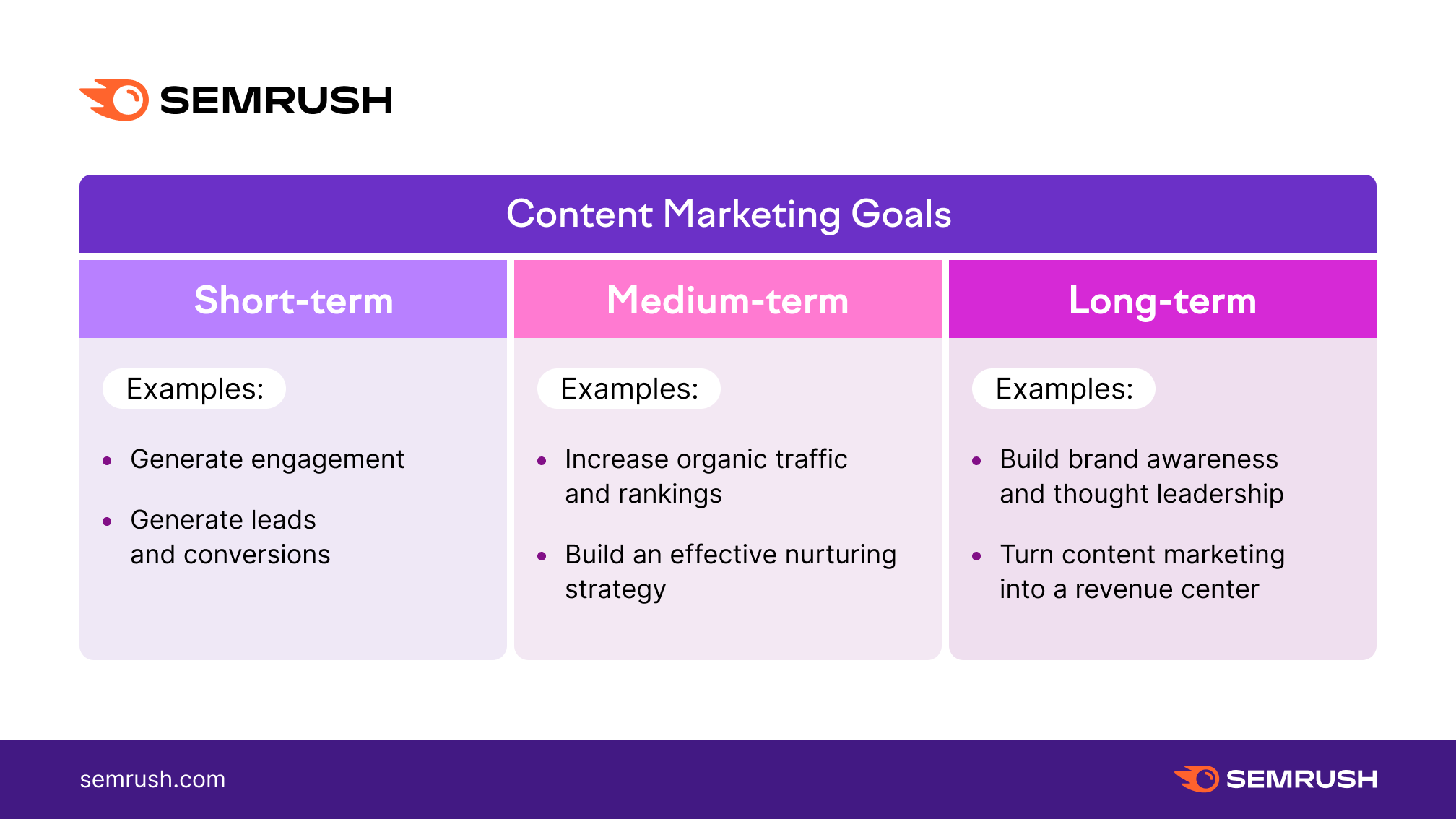
It's always a good idea to add more specific metrics to your goals. Download this free Content Mapping Template to access an editable version of the content metrics matrix:
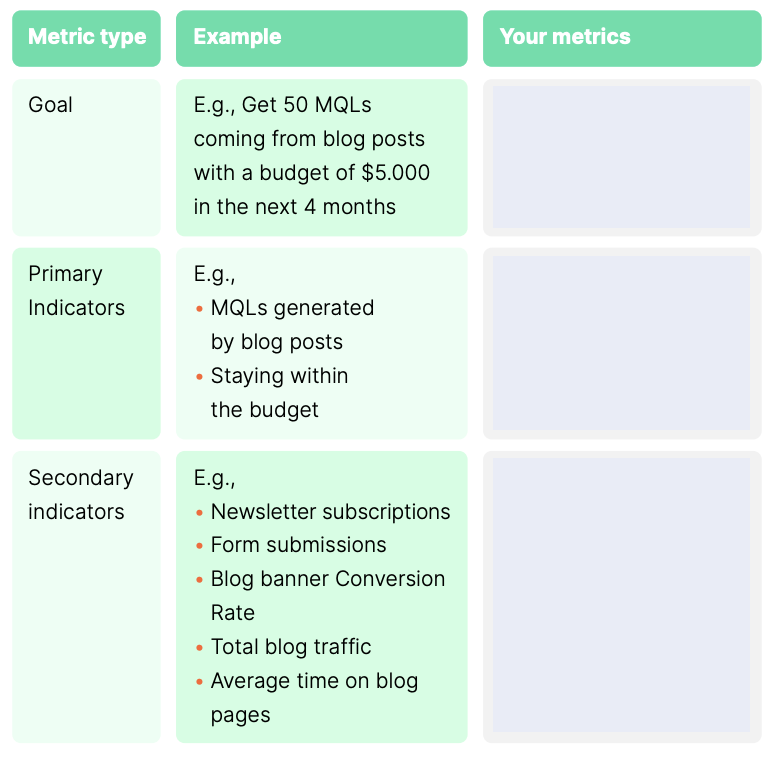
Your task:
Create a list of your primary and secondary content marketing goals. You will use it later to assign goals and metrics to each content piece and track its performance.Step 3: Assign resources and establish a schedule
Before you start planning content production, you need to assess the resources you have in place. Then, based on your available resources and your content marketing goals, you can estimate how much content you would like (and would be able) to produce and proceed to scheduling.
You should take into account such items as copywriting, design (both in-house and outsourced), research, promotion, etc. For example, if you have a goal of attracting at least 10,000 website visitors a month with your content and at least 300 leads, how content pieces should be produced with your existing content marketing budget? How much would each content piece cost you?
An effective calendar will help you further understand resources are being assigned. This is especially helpful when you need to respond to changing situations in an agile way. For example, when a piece of relevant news breaks and provides an opportunity for a timely article, you’ll require a quick turn-around. If you can see what people are working on, you’ll be able to re-prioritize production and get the new project underway.
Tamara Ceman of Practical Marketer recommends planning for the long haul while staying free and flexible for the immediate future:
Plan long term but leave room for agility and reactionary pieces. Markets are shifting more than ever and if your content calendar is too tight, you will struggle to adjust to changes in demand.
Tamara Ceman of Practical Marketer
The solution to this, Ceman explains, is to build your content calendar template with projects for the long term, while keeping empty slots free in the short term. According to Flying Hippo’s 80 percent rule, your content calendar should consist of 80% evergreen content and 20% timely content.
Scheduling Content
Of course, this all links to scheduling content. Andy Crestodina, the chief marketing officer and co-founder of Orbit Media Inc., says you need to take the length of your sales cycle into consideration, as well as your buying interval, and goals, when considering the desired cadence of your content calendar.
However perhaps the most important thing is prioritizing consistency over frequency:
If you don’t blog often that isn’t a bad thing; blogging randomly here and there is terrible. The biggest mistake is committing to a specific frequency, then not delivering on your promise to your audience.
Andy Crestodina, the chief marketing officer and co-founder of Orbit Media Inc.
Your task:
Review your existing content marketing budget and your goals. Determine where your content will be sourced from and which resources will be needed. For example, who are your copywriters, and who will help with design? Estimate the time and resources needed for each content type/piece. With your team, decide on how many content pieces you need to produce per month to meet your goals. You should also consider the posting frequency that will be optimal for both your production cycles and your customers.Step 4: List your ideas, categorize them and come up with content topics
As we’ve already mentioned, content ideas can come from many different parts of the organization – not just the marketing department.
Talk to your sales, customer service, and product teams to uncover common customer questions, doubts, or challenges. Go back to your customer research and buyer personas to analyze the high-level topics they are interested in. Analyze forums and industry publications. Use tools like Organic Research and Keyword Gap to analyze your competitors and find specific keywords they already rank for.Next, convert those insights into content topics in your calendar.
To expand your list of topics, use the Topic Research Tool: just enter your seed topic and get a list of topics, subtopics, and questions related to your core theme.
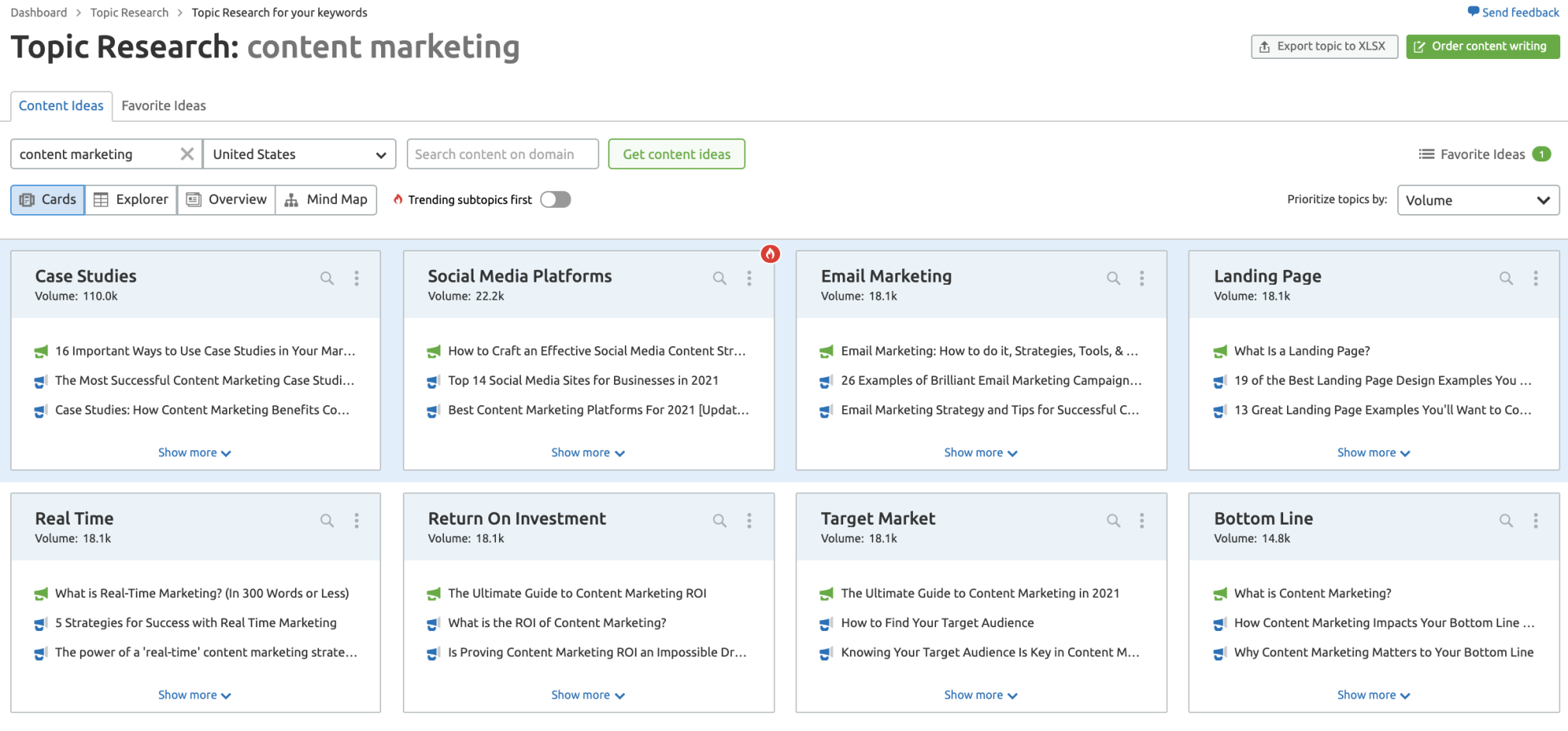
Case Study: Finding High-Performing Topics
The Barbauld Agency agency used Topic Research to generate content ideas that helped their client increase organic traffic by 133%. For example, they used the tool to find an idea for one of the most successful blog posts — a guide to correctly placing letterman jacket patches and pins, which now ranks #1 in search. To find the blog idea, they typed in the “chenille patches” keyword and drilled down to the related questions.
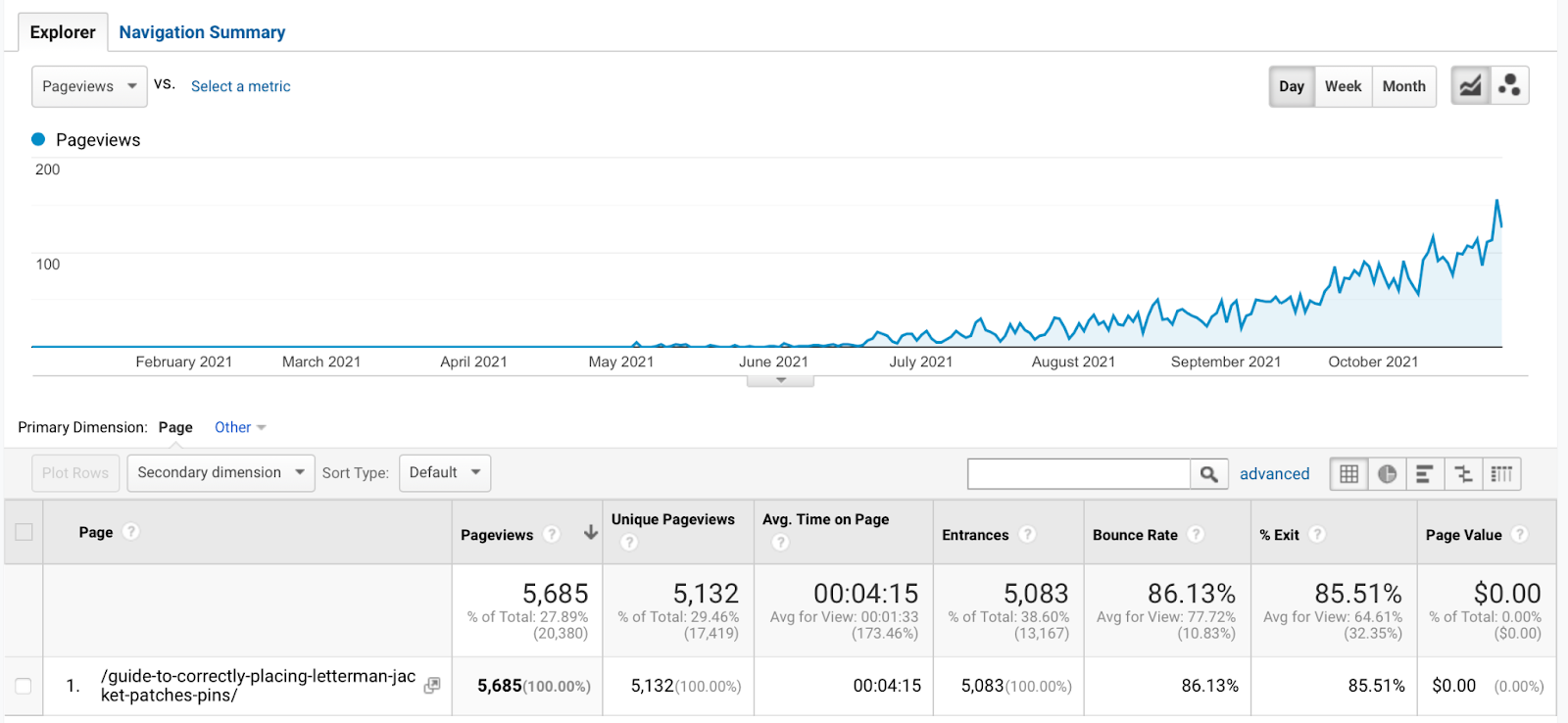
Running the Keyword Research and Creating Topic Clusters
Do you have all lists of potential themes and topics ready? Use the second calendar in our free template that includes all key steps to run keyword research and create keyword lists organized into content hubs.
Start with creating a generic list of keywords based on your previous research: put everything you have collected so far together in one place.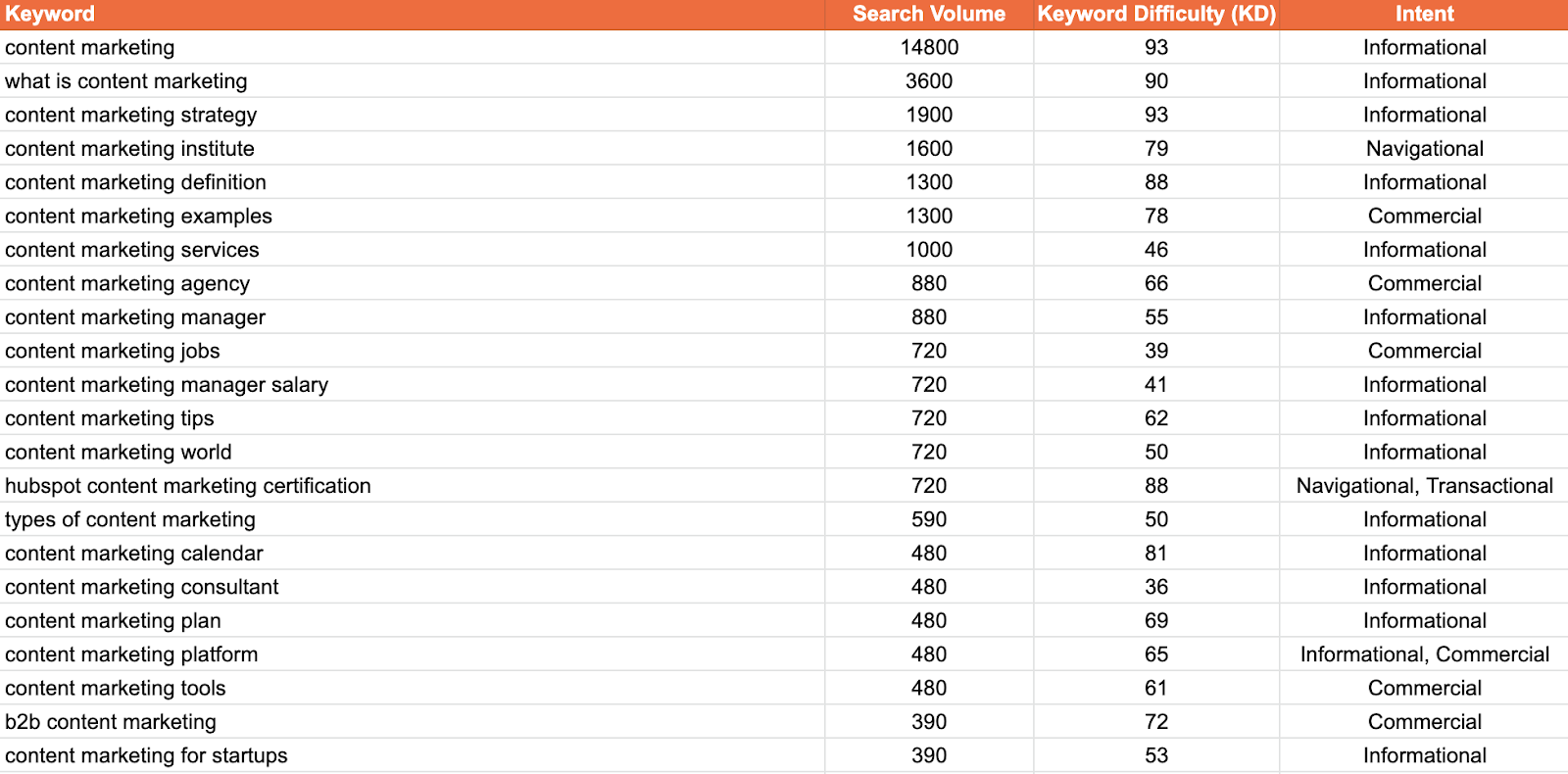 Break them down into transactional and informational keywords, and move each group to a separate tab.
Break them down into transactional and informational keywords, and move each group to a separate tab.Pro tip: Use the new feature in the Keyword Magic Tool that automatically shows intent for each of your keywords.
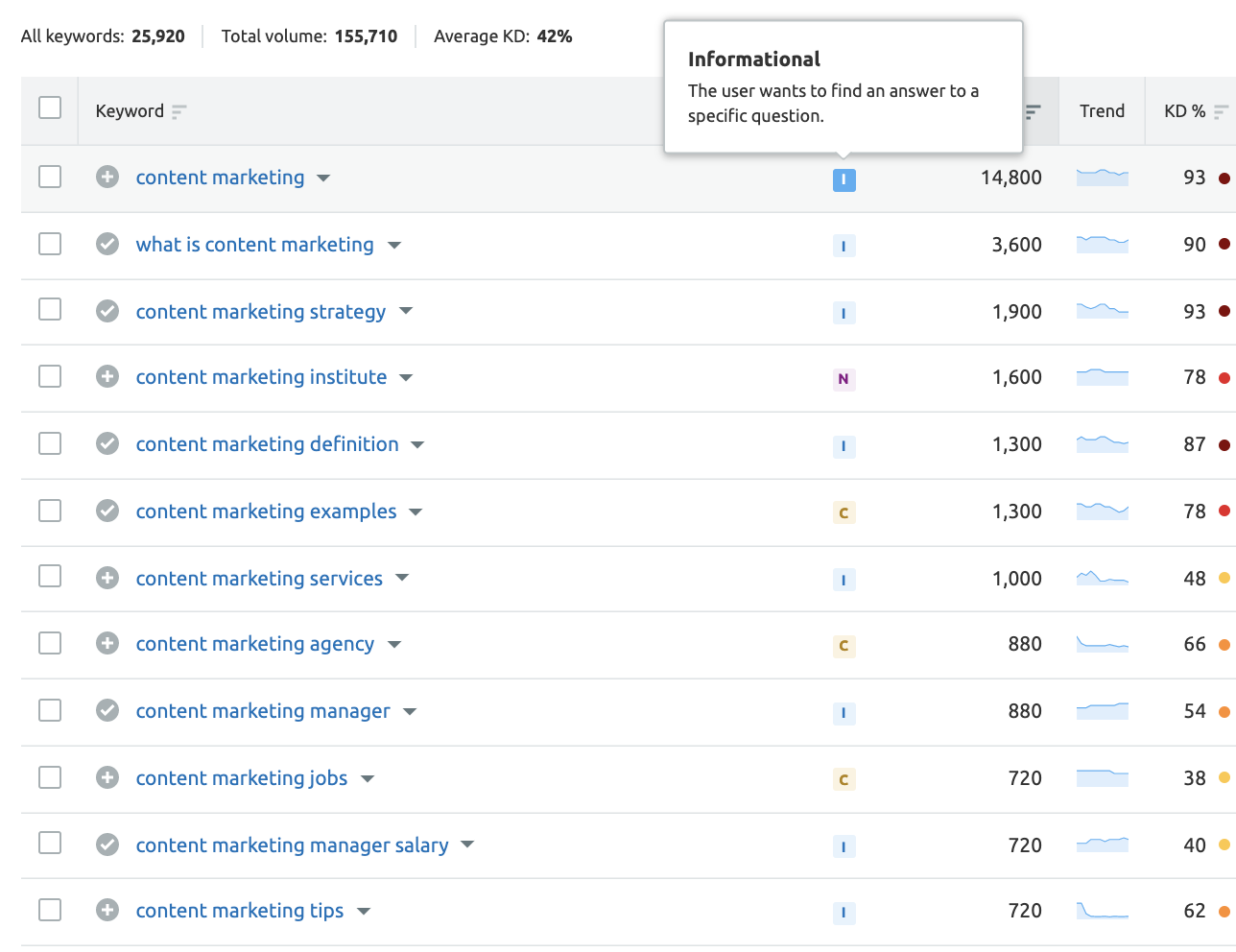 Prioritize your keywords by their search volume and keyword difficulty, leaving out those keywords that don’t seem to be promising.
Prioritize your keywords by their search volume and keyword difficulty, leaving out those keywords that don’t seem to be promising. For example, you might want to remove a keyword if the search volume seems to be too low or the keyword difficulty is too high.
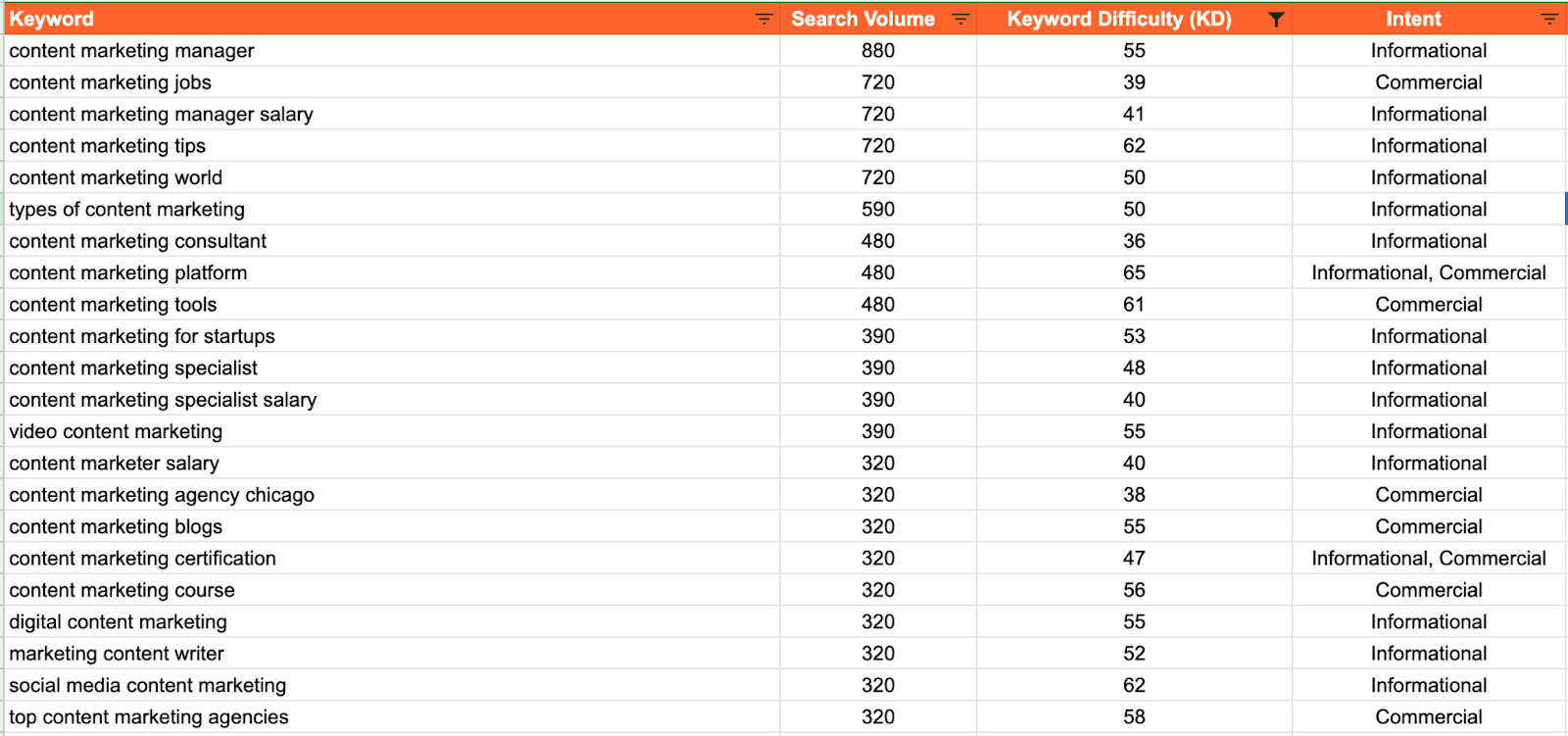
You can sort your data by search volume and add a filter to exclude keywords with a KD% higher than a certain number. You can also filter out some of those keywords directly in the Keyword Magic Tool.
Categorize your informational keywords: each category might correspond to a content hub (cluster) you’ll be creating.E.g., a ‘content marketing strategy’ keyword could be part of the ‘content marketing’ cluster, while a ‘sales funnel stages’ could be part of the ‘sales funnel’ cluster.).
 Decide which of the keywords to add to your calendar first and turn them into content headlines.
Decide which of the keywords to add to your calendar first and turn them into content headlines.There are multiple ways to prioritize topics and keywords. For instance, you might want to focus on building your content hubs one by one, creating cluster pages and pillar pages for each of them. Or, you might start designing several clusters simultaneously. You might also want to align your content calendar with upcoming campaigns and product releases.
Pro Tip: Remember that in addition to running keyword analysis, it’s important to involve the Subject Matter Experts (SMEs) in content planning to make sure you are heading in the right direction.
As a digital marketing manager serving in the professional services environment, I must use keyword planning tools to generate ideas for content.
Moshiur Rahman, a digital marketing and analytics manager for Canadian law firm Miller Thomson LLP
Moshiur Rahman, a digital marketing and analytics manager for Canadian law firm Miller Thomson LLP
However, it's equally important to rely on the expertise of the subject matter expert to get more granular or broader with each topic.
Moshiur Rahman, a digital marketing and analytics manager for Canadian law firm Miller Thomson LLP
Your task:
With your team, mind map the content topics you want to focus on. You will soon turn these into specific titles and formats. Run keyword research and create a list of keywords divided into thematical clusters. Add other ideas. Not every content idea in your calendar will be coming from keyword research. Most likely, the actual calendar will have a combination of content ideas based on your conversations with Sales (e.g., webinar ideas), on keyword research (e.g., blog posts), industry trends (e.g., ebooks), and so on.Step 5: Pick formats to suit your audience
Now that you have reached this point, you should be thinking about how your content calendar can help you plan which formats you want to use. Formats could include blog posts, social media posts, and video content, depending on the types of content your audience most likes to consume. Think about the formats your audience is most likely to prefer and how various topics you have identified would fit those potential formats.
Be sure to target each piece of content to specific readers or buyers and that it also maps to their buyer’s journey. Who you are targeting and what they need to achieve will help you determine how you should deliver your content.
When speaking to a B2B audience, note that buyer personas are often complex and buying decisions are more process-oriented. This needs to be reflected in your content calendar — and might mean your content is more granular.
Myeisha Thompson, principal copywriter and content strategist for MPower Content in Arizona, recommends setting aside extra time to talk to B2B audience members to make sure your content really hits home.
It’s important to remember that you’re talking to a person, a consumer — not just a business. Your content calendar should leave room to speak to B2B decision-makers on a more personal level to build that all-important know, like, and trust.
Myeisha Thompson, principal copywriter and content strategist for MPower Content in Arizona
For a deeper dive, check out our study on how to build a content marketing funnel.
Your task:
Decide which content formats would work in your situation. For example, if you are a B2B company, you may wish to run webinars and produce whitepapers. Alternatively, if you are a B2C ecommerce company, you might like to focus on blogging and Instagram stories. You may have a combination of both too! This will help you fill the Content format field in your calendar.Step 6: Choose which promotional channels to use and how to repurpose content
With content ready to publish, you will need to choose where and when you want to promote it. Of course, this can be done on all your social media, but you may also want to share it via your newsletter, through influencers, or even via paid search channels. More visitors early on tend to mean more shares, backlinks, and organic traffic later.
As part of getting the most out of your content, you will have to repurpose it and make it native to each of the platforms you want to publish it on. As such you will also need to set aside time for re-working pieces of content to make them more suitable for each new channel you want to put them on. To learn more explore our guide to repurposing content.

Your task:
For every content piece you produce, you must decide which channels would be most effective for promotion. This will help you fill the Promotion field in your calendar.Step 7: Open your calendar to different teams
It’s important to open up your calendar, says David McCarthy, a content marketing strategist in Chicago. He recommends socializing the calendar to make sure your content team has access. This brings the creative side of your business closer to the planning phase.
It can help position the (content) team not as a "group of writers and grammar enthusiasts" but as a critical part of the company's pipeline-and revenue-building engine.
David McCarthy, a content marketing strategist in Chicago
Keeping tabs on your output via your content calendar can also help you identify bottlenecks and troubleshoot similar problems to identify speed bumps in the production process.
Moshiur Rahman, agrees. He says to share your calendar across your wider business, with the marketing, sales, and product teams, and keep it as simple as possible.
Collaboration and simplicity are the two most integral aspects of having a winning content calendar. It's essential to keep things manageable by making the process simple for everyone. The goal is to provide a tool for everyone to gather content insights and apply those insights to form captivating content.
Moshiur Rahman, a digital marketing and analytics manager for Canadian law firm Miller Thomson LLP
Ultimately, this will create synergies and allow them to repurpose your lovingly created content. It will also give your sales and product departments access and help align your plan with that of the business as a whole.
Your task:
Decide which team members or departments need to get involved. Share your calendars with them, explaining exactly what it is and why you would like their input and collaboration.Step 8: Use your content calendar template to measure productivity
When you are building your content calendar template, you can include columns that allow you to record snags in the production cycle. There are red flags that can indicate where delays are not one-off incidents, but rather recurring problems.
Start by using the content calendar to record the average length of time needed to create a piece of content. When delays happen and deadlines are missed, you should record what type of asset the piece fits under, and which contributor handed in the work late.
This way, you can begin identifying where problems are happening on an all too regular basis, before working to fix them.
At the same time, you can also use your calendar to track content performance. For example, you can add the target KPIs (metrics) for each content piece in the calendar and check whether it performed well later.

Your task:
Fill out the KPI column in your content calendar with metrics for each content piece. For example, it could be ranking, traffic, shares or leads. Go to the results tab in the template to measure your success over time and see which topics, formats and channels perform best. Analyze whether content is produced on time and with a planned cost, and if anything needs to be adjusted in the content production cycle.Making the Most out of Your Content Calendar
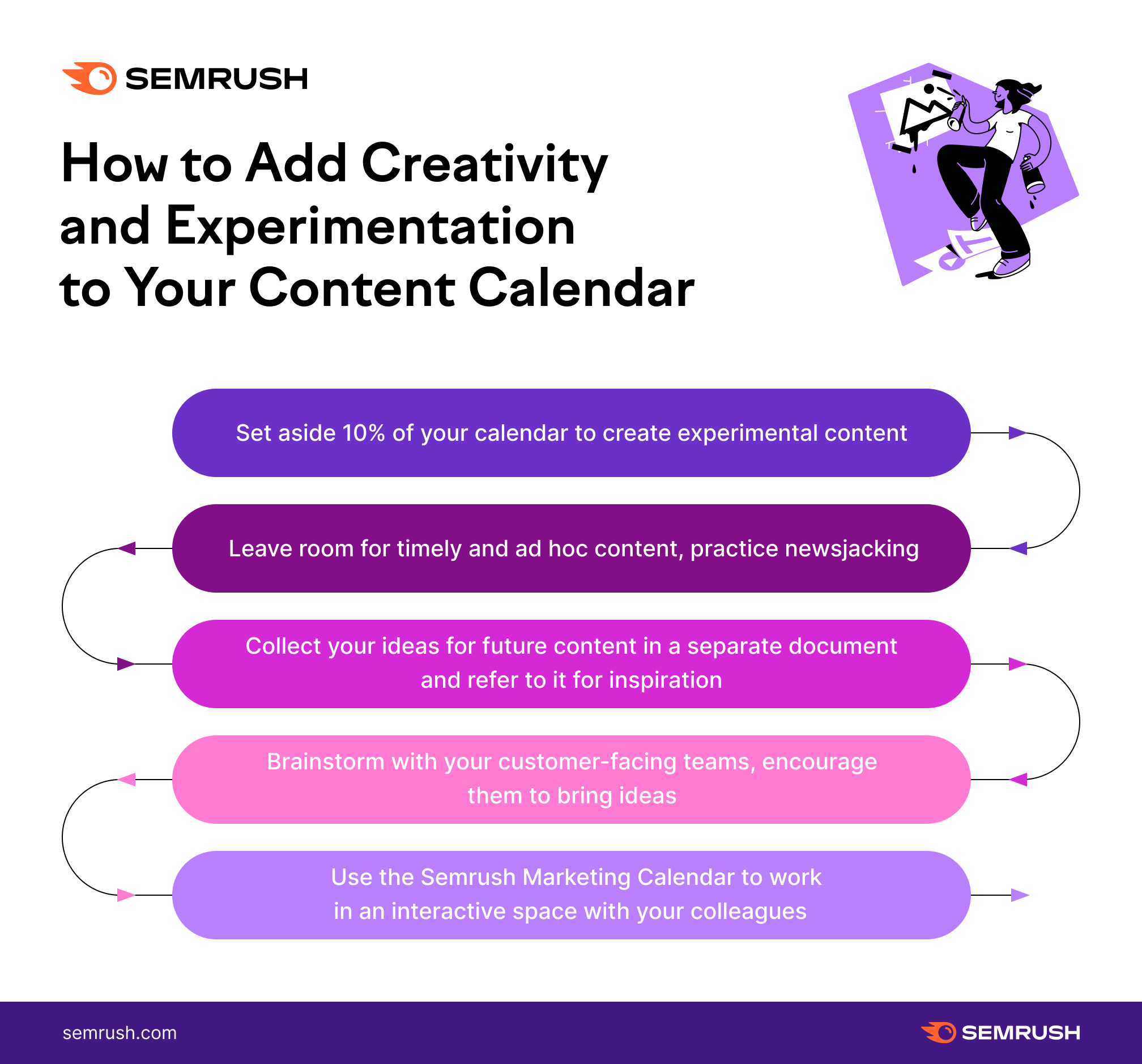
Make sure your content calendar has free space that brings agility, flexibility, and allows you to hijack news and viral events to further the agenda of your content marketing.
Once you are regularly publishing content, make sure you monitor its performance after it has been released into the big wide world. Tools like the Semrush ImpactHero use artificial intelligence to provide data insights on how your content performs.
Armed with this knowledge, you can make more space in your calendar for what works, while edging out what does not.
You can also use tools to take your content planning to the next level. One example is the Semrush Marketing Calendar, which sets your teams up with a more interactive workspace than that provided by a document.
Here are a few final ideas from expert contributors, to help you make the most out of your content calendar template:
Find Time to Experiment
McCarthy in Chicago recommends blocking off a set amount of time each month in your content calendar template so that you have time to try new things.
I've also had success with planning and creating a calendar when I block off space for experimentation. The ever-changing audience preferences and algorithms require constant innovation. Blocking off, say, 10 percent of the month to experiment with new content types enables that evolution that's essential digitally.
David McCarthy, a content marketing strategist in Chicago
Keep Your Ideas Apart
Also keep potential ideas in a separate document that you can later refer to when it is time to update your content calendar or establish a new content calendar template.
Ching Chieh Li, a marketing specialist for Useme, based in Poland, says it is best to keep these ideas in one easy-to-reach place.
Have a central place to collect all of the ideas. I leave notes, ideas, related industry articles, and data in one place. Then check there when I am about to form the content calendar.
Ching Chieh Li, a marketing specialist for Useme, based in Poland
An Agile Content Calendar Template
So, there you have it. Armed with this information you are now prepared to set yourself up with an impressive content calendar template that will serve you time and time again. Good luck using it, and see what sort of content calendar template you can create for the coming year.
Innovative SEO services
SEO is a patience game; no secret there. We`ll work with you to develop a Search strategy focused on producing increased traffic rankings in as early as 3-months.
A proven Allinclusive. SEO services for measuring, executing, and optimizing for Search Engine success. We say what we do and do what we say.
Our company as Semrush Agency Partner has designed a search engine optimization service that is both ethical and result-driven. We use the latest tools, strategies, and trends to help you move up in the search engines for the right keywords to get noticed by the right audience.
Today, you can schedule a Discovery call with us about your company needs.
Source:





